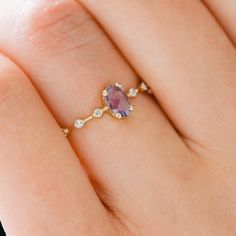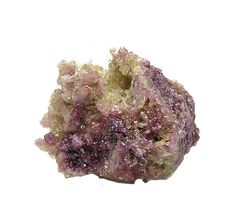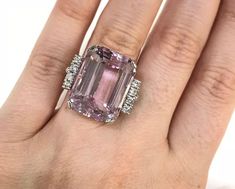Purple Colored Gemstones are a rich, splendid range of gemstones. A blue-red mix, purple, covers the spectrum while being warm and cold. Purple Colored Gemstones shine with a much more prevalent ruby, making the option of gemstones cool and yet even more appealing. Do you know the various forms of violet stones in the gemstones?
For decades, purple gemstones have been around for the manufacture of joys and objects. These stones may not be as common, although they are very handful, like other coloured gemstones.
The Purple Colored Gemstones, derived from chemical inclusions, is generally supposed to provide a “clarity of thoughts.” The purple colour is also linked to richness and power. Cardinal gemstones, including mauve, lavender and lilac, exude in various shades of lilac. Deeply coloured gemstones are rare and the most costly thus.
Many people buys gems by type, such as saphir, turmaline or amethyst. They buy gems by type. But one thing we have found in the colourful gem industry is that most consumers focus mostly on colour and less on gems, as long as they buy the stone that will last long enough to achieve their goal. Give your quest for gemstones by colour as colour is also the most important thing for most people when it comes to shopping loose gemstones.
It can also be difficult to find gems by colour, because websites prefer to arrange their inventories around gems instead of colours. There is a list of gem varieties grouped by colour for those who want to know their choices in specific colours.
Table of Contents
- List of All Purple Colored Gemstones
- 1. Alexandrite
- 2. Taaffeite
- 3. Purple Opal
- 4. Purple Garnet
- 5. Purple Tourmaline
- 6. Purple Sapphire
- 7. Tanzanite
- 8. Purple Spinel
- 9. Purple Zircon
- 10. Purple Idocrase
- 11. Kunzite
- 12. Scapolite
- 13. Purple Topaz
- 14. Amethyst
- What is the rarest purple gemstone?
- Are purple stones valuable?
- What is the rarest rock on Earth?
Why people love Purple Colored Gemstones
Violet is a blue and red blend. These two special colours have a distinct identity in purple; a soothing colour like blue purple but with an intense red colour.
Purple also represents:
- Power
- Luxurious
- Creativeness
- Magic
- Wisdom
List of All Purple Colored Gemstones
1. Alexandrite
Alexandrite is a mineral chrysoberyl color-changing gemstone. Alexandria can also transform into Purple Colored Gemstones under a glowing light at night while appearing green at daylight in addition to red and pink. A rare mineral the color-changing gemstones are next to diamonds with costs up to $45,000 per carat the most expensive purple gemstones. The traditional birthplace for June is Alexandrite.

Also Read:- List of All Blue Colored Gemstones
2. Taaffeite
In addition to red, taaffeite is the first and only mineral found after cutting and facing of the stone. Formerly mistaken for a number of spinels, Richard taaffe, after whom the gemstone was called, described the Purple Colored Gemstones as a different mineral. Taaffeite, one of the rarest gemstones on earth, is therefore at around $6,000 a carat one of the most precious violet gemstones.

3. Purple Opal
Opal, while the most precious in black and most prevalent in white, is also a limp. The lilac is often present in the flash or the colours of the body. The opal stone will appear entirely purple if cut to only include this colorset. The birthplace for October is Opal generally. Opal is a birthplace of Libra in astrology.

4. Purple Garnet
Garnet, which is most common in red, is also found as purple stones. The lilac crystals come from the so called pyrope and spessartine varieties of grenets. Blue garnet, the rarest of all grenades, turns violet under a flaming sun. It is one of the most costly purple gemstones with values up to $3,000 per carat. Grenet is typically January’s birthstone. Aquarius is birthstone of astrology.

5. Purple Tourmaline
Tourmaline also appears as purple stones as a gemstone used in all rainbow colours. The purple crystals derive from tourmaline species known as elbaite including the very precious turmaline of Paraiba. Although the rose variety has been mentioned, the birthplace in October is common to all coloured tourmalines. Tourmaline in astrology is Leo’s birthplace.

6. Purple Sapphire
Sapphire is also most common in blue as purple stones. This purple joy is made of the corundum mineral of all kinds, except the red one known as a ruby one, called sapphire. A colour shift from blue and Green outdoors to a violet stone under a flashing light indoors also occurs. While a traditional April birthplace, sapphire is the modern September birthplace in general. Sapphire is Taurus’ birthplace of astrology.

7. Tanzanite
Tanzanite, though often present in blue, is most often classified as violet gemstones and is a contemporary example of purple gemstones. This purple crystal is a zoisite type, which was discovered only in Tanzania in 1967 (hence the name Tanzanite). It is also a glassy mineral found in green and yellow. Tanzanite has become a prominent purple gem, which was declared the modern birthplace of December as the relatively new gemstone.

8. Purple Spinel
The spinel is also common in red as purple stones. This purple half-precious rock glassy in clarity and lustre is pale in intensity and thus looks rather than lilactar or lavender. The purple crystal is very hard and strong at 7.5 to 8 in the Mohs Scale and makes the purple gem ideal for jewellery.

9. Purple Zircon
In certain cases, zircon is a replacement for diamond, whether in terms of transparency, lustre or hardening. Zircon is most common in blue, but also in violet stones. Zircon is December’s traditional birthplace. The gemstone is in astrology linked to the zodiacal Virgo sign.

10. Purple Idocrase
The mineral vesuvianite is known as Idocrase. In addition to yellow and green, idocrase is often found as violet stones. This purple crystal is coloured by the addition of manganese. That is why the purple stone is separately known as manganese-vesuvianite in mineralogy.

11. Kunzite
As hiddenite is green, Kunzite is the violet variety of spodumene. The glassy violet gem is pale in intensity, and thus comes across more as purple than lilac, as the name follows the jeweller George Frederick Kunz. The violet crystal is coloured because manganese is minimally incorporated into the otherwise colourless mineral

12. Scapolite
Scapolite is a collection of minerals often produced as violet stones. The violet scapolite crystals used in jewellery are made of marialite minerals. A glassy lustre and Mohs scale of a hardness of 6.5 to 7 render the violet gem transparent. Marialite, a rare mineral, is both a favourite gemstone and stone of collection.

13. Purple Topaz
Whereas in yellow and blue it is most common, topaz is also found as purple stones. This purple crystal, a variation of imperial topaz, is an uncommon colour of the topaz. Via the incorporation of the chromium into the otherwise colourless mineral, violet crystal varies from light violet to deep violet. In general, Topaz is the gemstone of the Sagittarius zodiac sign.

14. Amethyst
Amethyst is the traditional pure gemstone representation. Since ancient times, the amethyst almost always comes to mind when purple gems are described. The purple gemstone is the purple quartz type. The purple gem was then highly valued, in reality, one of the precious stones that diminished the importance of purple stone until the 18th century, when large amethyst supplies were discovered in Brazil.

What is the rarest purple gemstone?
Benitoite is the rarest purple gemstone. Benitoite is a strange blue to purple gemstone found in 1907 in California’s San Benito mountains.
Are purple stones valuable?
The spectacular piercings are very rare and costly, especially when the stone is bright and colourful. Lilac, Orchid, Lavender, Grape and Plum Diamonds, which describes the colour of a pier, are known to contain purple diamonds.
What is the rarest rock on Earth?
Painite: Painite holds the Guinness World Record not only for the rare gemstone but also for the rarest mineral on earth. Just 2 specimens of Painite existed for the next several decades after its discovery in 1951. By the year 2004, there were less than 2 dozens known gemstones.




